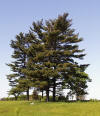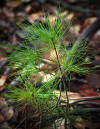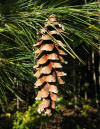



_-_Guelph,_Ontario_2020-06-19_(01)_small.jpg)

WILD
FOODIES' HOME PAGE
PLANT PROFILE LIST
NAME: White Pine
SPECIES / FAMILY: Pinus Strobus / Pinaceae
OTHER COMMON NAME(S): eastern white pine, northern white pine, white pine, soft pine
CONDITIONS:
sun-partial shade
|
PARTS: |
EDIBLE |
TASTE |
RAW/COOK |
SEASON |
|
All |
|
|
|
|
|
Shoots |
|
|
|
|
|
Leaves |
|
pine |
RAW/STEEP/DRY |
all |
|
Stalk/Stem |
|
|
|
|
|
Buds |
||||
|
Flowers |
|
|
|
|
|
Fruits |
|
|
|
|
|
Pods / Cones |
|
|
||
|
Seeds |
|
nutty |
RAW/COOK |
|
|
Nuts |
|
|
|
|
|
Roots |
|
|
|
|
|
Bark |
|
sweet |
RAW/COOK |
all |
PORTION: small
COMMENT: White Pine needles are a great source of Vitamin C! Needles can be dried, cold infused, blended and sieved through a cloth, or steeped as a tea. // Seed - small and fiddly, mainly used as a flavouring in cooking. The fresh needles are brewed into an aromatic tea that is rich in vitamins A and C. Candy is made by boiling the tender new shoots in syrup. The sticky amber sap can be used for chewing. A vanilla flavouring is obtained as a by-product of other resins that are released from the pulpwood. The firm unexpanded male cones can be boiled and used as a pleasant sweet flavouring. Inner bark - raw or cooked, sweet flavor, often dried, ground into a powder and then used as a thickener in soups etc or added to cereals when making bread. The species is monoecious (individual flowers are either male or female, but both sexes can be found on the same plant) and is pollinated by wind. The plant is not self-fertile.(1) Young pine roots are edible as are stripped pieces of their bark. The bark can be seeped in water for its sugar and the water drank.(2) Cones are also edible, particularly the young green ones.(8)
CAUTION: Sieve pine needles through cloth (or handkerchief) to avoid swallowing them. Pine needles are a natural blood thinner, as with many other foods (salmon, garlic, almonds, wild blueberries, etc.), therefore overconsumption can lead to nose bleeds, etc..// The wood, sawdust and resins from various species of pine can cause dermatitis in sensitive people. Avoid if allergic. Avoid internally if suffering from asthma or bronchitis. The astringent taste may cause stomach discomfort.(1)
NUTRITION/MEDICINAL: Pine needles (best raw) and bark are a big source of vitamin C, older needles have more vitamin C than younger needles - https://www.wildedible.com/pine-needle-tea-natural-vitamin-c,
Also, Antiscorbutic; Demulcent; Diuretic; Expectorant; Miscellany; Pectoral; Poultice; Salve.(1)White pine was employed medicinally by several native North American Indian tribes who valued it especially for its antiseptic and vulnerary qualities, using it extensively in the treatment of skin complaints, wounds, burns, boils etc. It is also very beneficial to the respiratory system and so was used in treating coughs, colds, influenza and so on. The turpentine obtained from the resin of all pine trees is antiseptic, diuretic, rubefacient and vermifuge. It is a valuable remedy used internally in the treatment of kidney and bladder complaints and is used both internally and as a rub and steam bath in the treatment of rheumatic affections. It is also very beneficial to the respiratory system and so is useful in treating diseases of the mucous membranes and respiratory complaints such as coughs, colds, influenza and TB. Externally it is a very beneficial treatment for a variety of skin complaints, wounds, sores, burns, boils etc and is used in the form of liniment plasters, poultices, herbal steam baths and inhalers. A poultice of pitch has been used to draw out toxins from boils and reduce the pain. The dried inner bark is demulcent, diuretic and expectorant. An infusion was used as a treatment for coldsand it is still used as an ingredient in commercial cough syrups, where it serves to promote the expulsion of phlegm. A poultice made from the pounded inner bark is used to treat cuts, sores and wounds. The wetted inner bark can be used as a poultice on the chest in treating strong colds. The dried inner bark contains 10% tannin, some mucilage, an oleoresin, a glycoside and a volatile oil. A tea made from the young needles is used to treat sore throats. It is a good source of vitamin C and so is effective against scurvy. An infusion of the young twigs has been used in the treatment of kidney disorders and pulmonary complaints. The powdered wood has been used as a dressing on babies chaffed skin, sores and improperly healed navels. (1) PFAF
More medical links:
https://www.webmd.com/diet/what-to-know-pine-needle-tea
https://www.motherearthliving.com/health-and-wellness/all-purpose-pine-zm0z18ndzpop/
PINE TREES - GENERAL INFORMATION:
POISONOUS LOOK-A-LIKES:
The yew doesn't really look like White Pine, more like a Spruce, but it's good to know that the Yew is toxic (including the fruit's seed) except the flesh of the fruit, which is edible. https://en.wikipedia.org/wiki/Taxus_baccata
This is NOT completely accurate: "...yew trees, Norfolk Island pine, lodgepole pines, and ponderosa pine are poisonous, and should be avoided at all costs."
PFAF says that some parts of Ponderosa Pine are edible, but NOT the needles. It is found mainly in the Western US. https://pfaf.org/user/Plant.aspx?LatinName=Pinus+ponderosa
Some Lodgepoll Pines are edible, particularly in Eastern US - https://pfaf.org/USER/Plant.aspx?LatinName=Pinus+contorta, HOWEVER others are not, particularly in the West https://pfaf.org/user/Plant.aspx?LatinName=Pinus+contorta+latifolia
OTHER USES: Kindling, pine cones & dry needles burn very well. // Dye; Gum; Herbicide; Miscellany; Pitch; Waterproofing; Wood. A tan or green dye is obtained from the needles. The needles contain a substance called terpene, this is released when rain washes over the needles and it has a negative effect on the germination of some plants, including wheat. Oleo-resins are present in the tissues of all species of pines, but these are often not present in sufficient quantity to make their extraction economically worthwhile. The resins are obtained by tapping the trunk, or by destructive distillation of the wood. In general, trees from warmer areas of distribution give the higher yields. Turpentine consists of an average of 20% of the oleo-resin and is separated by distillation. Turpentine has a wide range of uses including as a solvent for waxes etc, for making varnish, medicinal etc. Rosin is the substance left after turpentine is removed. This is used by violinists on their bows and also in making sealing wax, varnish etc. Pitch can also be obtained from the resin and is used for waterproofing canoes, containers etc, as a wood preservative etc. Wood - straight and close-grained, light, soft, not strong, works easily and takes an excellent natural or painted finish. A very valuable timber, the wood is especially suited for making the masts of ships and is also used for lumber, cheap furniture, house interiors, construction etc.(1) PFAF
SOURCE LINKS (may include nutritional and medicinal info, plus other uses):